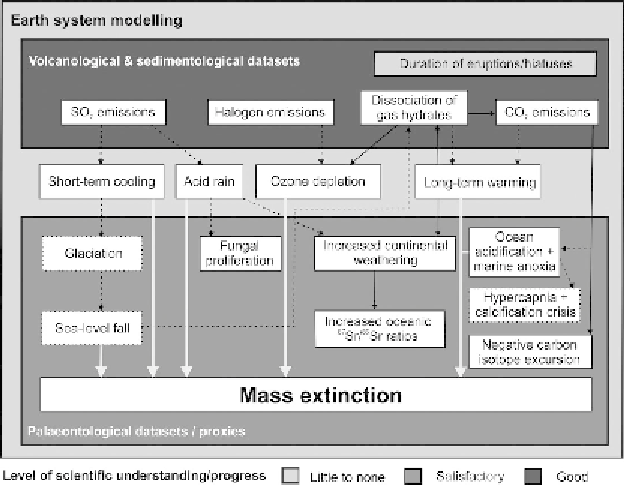Environmental Engineering Reference
In-Depth Information
Figure 11.4 Schematic illustrating some of proposed environmental effects and
Earth system feedbacks resulting from CFB volcanism (adapted from Wignall,
2001
). Not all volatile emissions and therefore feedbacks shown here are applic-
able to all CFB provinces. Dashed lines and dashed box outlines indicate effects
and feedbacks that are possible in theory but have not yet been fully quanti
ed or
are still debated in the authors
opinion. Bold light-grey arrows indicate main
mechanisms thought to cause a mass extinction (either terrestrial or marine or
both). Grey shadings indicate level of scienti
'
c understanding, and progress
of each discipline, illustrating that whilst quanti
fluxes from
CFB volcanism and palaeontological proxies are available (dark grey and grey),
some key mechanistic understanding that links the two is missing (light grey).
Figure modi
cation of volatile
a short-term cooling effect from sulfuric acid aerosol particles lasting years to
decades, and acid deposition leading to damage of vegetation and ecosystems
(Black
et al
.,
2014
). Proposed long-term effects include global warming from CO
2
released by the eruptions lasting tens to thousands of years (Sobolev
et al
.,
2011
).
The dashed lines in
Figure 11.4
illustrate that there is substantial uncertainty
concerning the exact mechanisms, extent and Earth system feedbacks associated
with many of the proposed effects. For example, there is debate about the link
between Deccan volcanism CO
2
emissions and the effect on Late-Cretaceous
temperatures (e.g. Caldeira and Rampino,
1990
; Chenet
et al
.,
2008
). Volcanologists
have made considerable progress constraining volatile
fluxes during individual
CFB eruptions (see also
Chapter 20
) and, similarly, palaeontologists have gathered

